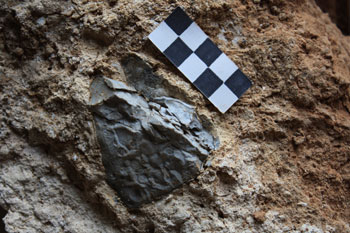Cave holds earliest signs of fire-making in Europe
Burned bone and heated stone in the Spanish cave date back 800,000 years

Discoveries in a Spanish cave indicate a prehuman species set small blazes there around 800,000 years ago. It’s the earliest evidence for fire-making in Europe.
LIZ WEST/FLICKR (CC BY 2.0)
By Bruce Bower
Ancient cave dwellers some 800,000 years ago were trailblazers. They lit small, controlled fires in what is now southeastern Spain, a new study finds.
This discovery provides the oldest evidence of fire-making in Europe. It also supports the idea that members of Homo (the same genus as modern people) regularly lit fires at least 1 million years ago.
Michael Walker is a paleontologist at the University of Murcia in Spain. He and his colleagues conclude that fire-making began in Africa, before moving north to the Middle East and Europe.
Walker and others have been excavating artifacts at the Spanish cave, named Cueva Negra del Estrecho del Rio Quípar. They uncovered more than 165 stones and stone artifacts that all showed signs of heating. They also found about 2,300 fragments of animal bones that showed signs of heating and charring.

Walker’s team describes its findings in the June issue of Antiquity.
How they dated the remains
The burned objects were found 5 to 7 meters (16.5 to 23 feet) inside the cave. That’s far enough inside the entrance, the researchers say, that it’s unlikely any burning there was sparked by some brush fire outside. Plus, the shrubs needed to fuel a brush fire probably didn’t grow near the cave. Back 800,000 years ago, this cave appeared to have bordered a river and swamp.
The cave held a range of stone tools. Similar tools have been found at other sites where there are signs of ancient fire-making. Concludes Walker, these tools indicate that the users had advanced technical skills. They likely knew which wood and stones were best for striking sparks onto piles of kindling.
Walker and other scientists have studied Cueva Negra and dated the layers of sediment making up its floor. Earth’s magnetic poles shifted around 780,000 years ago. This change in its magnetic field was evident in the sediment layer just above where the burned material was found. That told Walker that the fire had been set near this time.
But other researchers suspect the artifacts may not be quite that old. Earth’s magnetic poles have flipped many times in the distant past. Indeed, evidence of several flips appears in the cave’s sediment layers, notes Juan Manuel Jiménez-Arenas. He’s a biological anthropologist at the University of Granada in Spain. His team suspects that members of the Homo genus made tools in this cave no more than 600,000 years ago. That’s the conclusion they reported in a 2011 paper. Argues Jiménez-Arenas, 600,000 years is the oldest possible age for European stone artifacts like those found in the Spanish cave.
Scientists need to do more studies to assess the age of artifacts in the cave. But if Walker’s estimate holds, the cave will join a small but growing club, says archaeologist John Gowlett. He works at the University of Liverpool in England. Gowlett says that the cave would be one more of a “surprising number” of sites from deep in the Stone Age that show evidence of small, intentionally lit fires.
Walker’s team says that fossils of extinct animals found along with the stone tools support the 800,000 year old estimate for fire-making. Yet even at 600,000 years old, the artifacts would still predate other evidence of controlled fire in Europe.







